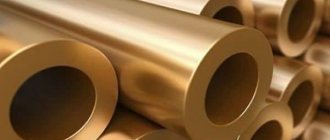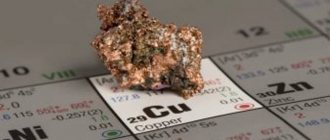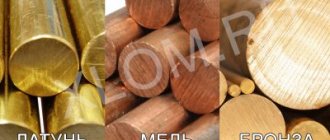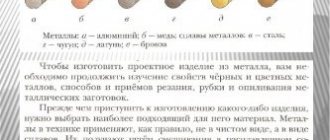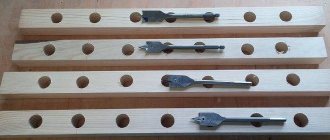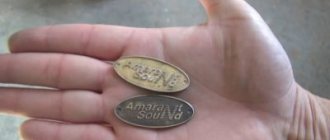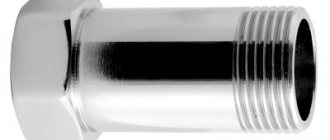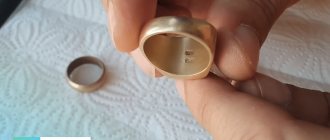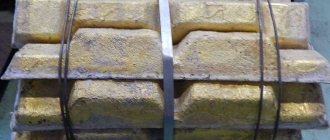Plumbing equipment breaks down at the most inopportune moment. In a store, you hastily buy a seemingly decent faucet at a very low price, suspecting nothing. And three months later, history repeats itself - the material turned out to be too weak. Let's learn how to choose high-quality plumbing fixtures and figure it out: silumin or brass - which faucet is better?
Silumin and brass faucets: which material to choose
There are silumin and brass faucets on the plumbing market. Their prices are noticeably different. Let's find out what the difference is and which product to give preference to.
Silumin and brass are the main materials from which faucets are made. There are a large number of enthusiastic reviews about silumin mixers, and there are no less fans of brass fixtures.
What is silumin
Silumin is an alloy of aluminum and silicon. The composition may contain impurities of copper, titanium, magnesium and manganese, which are added specifically. The presence of iron, calcium, and zinc indicates insufficient purification of the substance. It is not uncommon for sodium or lithium to be present.
Aluminum is the basis of the alloy: its content is about 90%. This explains the external and qualitative similarity of aluminum and silumin. Both metals are gray, silvery when cut, and have low density. Like aluminum, silumin is not afraid of corrosion due to a protective film of oxide compounds.
The physical properties of silumin depend on the second component. Silicon makes it strong and wear-resistant. The material can withstand heavy loads, but up to a certain point. After passing the strength threshold, silumin becomes brittle and brittle.
Aluminum-silicon compounds have a low melting point - about 670 °C. Because of this, the cost of the alloy is lower than that of other metallic substances.
You might be interested
How is silumin marked?
Marking of alloys is carried out based on the requirements of international standards of the ISO system:
- “AL 9” means: A - aluminum, L - foundry, 9 - percentage of additional constituent substance.
- “AK 15” is marked according to the same principle, only the letter “K” means “Silicon”.
Includes:
- 90% main component (aluminum);
- about 9% silicon;
- manganese up to 0.5%;
- titanium up to 0.1%;
- copper up to 0.6%;
- zinc up to 0.3%.
Marking is done as follows: for example, silumin alloy is AK5 Ts8. A is aluminum, K is silicon in an amount of 5%, C is zinc in an amount of 8%.
Silumin mixers
Products made from an aluminum alloy with silicon are economy-class plumbing fixtures.
Silumin mixers have the following advantages:
- Strength;
- Corrosion resistance;
- Wear resistance;
- Light weight;
- Low cost.
But these advantages give way to serious disadvantages, the main one of which is fragility. Temperature changes, pressure changes, careless installation and other factors can render the faucet unusable within a few months.
Silumin mixers cannot be repaired. Even if you managed to select a gasket and pack the cracked product tightly, it will soon leak in another place.
Alloy groups
Silumin alloys are divided into several groups. This distinction is made according to the purpose of the materials:
- AK 12 is a eutectic silumin containing 12% silicon. During heat treatment, the casting is not strengthened and does not become hard during shrinkage. Parts made of such material are structurally designed for sealed low-load devices.
- Highly alloyed hypereutectic silumin is labeled, for example, AK4M5. Belongs to the piston group and is used when performing work under high-temperature conditions. It has high resistance to high temperatures and wear resistance. The use of this alloy for particularly important products operating under high load conditions. These are large-sized and critical parts.
What is brass
This is an alloy based on copper and zinc. The amount of additional component does not exceed 30%. Zinc is cheaper than copper, and therefore the higher the content of the former, the lower the cost of the material. But such a solution worsens the quality of the finished alloy.
Let's consider how additives affect the properties. The brass composition is diluted:
- Nickel (increases strength and corrosion resistance);
- Tin (solves the problem of rust in salt water);
- Silicon (increases anti-friction qualities, but reduces hardness and strength);
- Lead (simplifies processing, reduces strength);
- Manganese (anti-corrosion component that improves mechanical characteristics, the effect is further enhanced by tin, aluminum, iron).
Brass alloy is the most popular in the world. Due to its high strength and wear resistance, it is called the “eternal metal”. The material does not rust and is not afraid of aggressive external factors.
The melting point reaches 950 °C. For this reason, and also because of the high cost of copper, the production of the alloy is more expensive than the production of silumin. They reduce the price by increasing the zinc content. Changing the proportion simplifies the technology for preparing the alloy, but with a zinc content of 20% or more, brass cracks in a humid environment.
You might be interested
Brass faucets
Plumbing fixtures made of copper-zinc alloy belong to the luxury class. Brass faucets are valued for the following advantages:
- Strength and hardness;
- Wear resistance;
- Reliability and durability.
Copper-zinc products will last at least five years. Brass plumbing looks solid and is quite heavy. Thick cast walls and correct threaded connections minimize the likelihood of leakage. This type of plumbing can be repaired. The selection of parts is also simplified by the fact that European manufacturers of plumbing fixtures use the same standard sizes. At the same time, Chinese companies allow a difference of several millimeters.
A significant disadvantage of brass faucets is their high cost. But if you take into account the service life, the purchase will be profitable.
How to distinguish a silumin faucet from a brass one
First of all, focus on cost. For a brass faucet it is an order of magnitude higher than for a silumin faucet. Aluminum-based products are more often offered by Chinese manufacturers. It is difficult for a non-professional to determine it by eye. Focus on weight - silumin products are light, as if they were plastic. But some manufacturers practice adding weights to make budget products pass for luxury. Therefore, always check the product documents.
This will avoid purchasing a low-quality brass faucet. Products with a high zinc content in operation resemble silumin. A leak can form within a month. But only in this case it is more likely to appear not even on the thread, but on solid elements. In addition, low copper content creates the danger of zinc leaching, which negatively affects the quality of tap water.
You might be interested
Description of material
The definition of silumin is easy to find on Wikipedia - it is an aluminum-based alloy with the addition of silicon. In this case, the content of the additional component ranges from 4 to 22%, and the main part is aluminum. The composition of the silumin alloy also contains a small amount of impurities of other metals: copper, calcium, titanium, iron, zinc, manganese and others.
Since the maximum amount of silicon is up to 22%, it is externally easy to distinguish it from real metal. It is slightly darkened, so it resembles cast iron, but only an experienced person will be able to actually recognize this material.
What is silumin in real life, and where is it found?
Which mixer to choose
It is always better to give preference to high-quality and durable brass plumbing fixtures. By installing such faucets in the bathroom and kitchen, you don’t have to worry about breakdowns and flooding.
In an office, cafe, restaurant, or in any public bathroom where taps are used intensively, you should install reliable brass plumbing fixtures.
Sometimes it is still more rational to choose a more budget-friendly silumin product. If the pressure in the system does not exceed 3 bar, the budget mixer is likely to last a long time. At the dacha, such plumbing will perform best. But in a new building or in a private house, where the pressure is higher, the available mixer will be “disposable” - the very first water hammer will destroy the structure.
It is also worth choosing silumin if there is no hot water supply.
When choosing a faucet, remember that this purchase is designed to serve you as long as possible, but take into account all the criteria so as not to overpay if high quality is not necessary.
What is better: cartridges or crane axle boxes?
Modern faucets use either cartridges with a ceramic plate inside or faucet axle boxes to mix hot and cold water.
There are two types of faucet axle boxes: In my opinion, faucets with cartridges are more convenient. There, only one lever is used to control the flow and temperature of the water. The service life of ceramics is determined by the amount of sand and sludge in the water pipe. If there is little or none at all, then a good cartridge will last you at least 7 years. The service life of ceramic faucet axleboxes is the same as that of cartridges. Therefore, the question of choosing between them is more a matter of personal preference.
Faucet axle boxes and cartridge for mixer
How to distinguish a brass faucet from a silumin one
New lines
- Profsan PSM 100 ELITE
- Profsan PSM 104 EQUIPMENT
- Profsan PSM 500 DESIGN
- Profsan PSM 300 STEEL
- Profsan PSM 301 STEEL BLACK
- Profsan PSM 303 STEEL GOLD
- Profsan PSM KVADRO
- Profsan PSM EURO
- Profsan PSM ECO
- Profsan PSM MODERN
- Profsan PSM STANDARD A
- Profsan PSM STANDARD B
- Profsan PSM PLUS
- Profsan PSM MEDIC
- Profsan PSM SHOWER
Kitchen faucets
- Profsan PSM 108 (wall-mounted)
- Profsan PSM 117 (herringbone)
- Profsan PSM 120 (herringbone)
- Profsan PSM 127 (herringbone)
- Profsan PSM 131 (herringbone)
- Profsan PSM 215
- Profsan PSM 335 (side handle)
- PROF ECO PSM 337 (side handle)
- ProfSan PSM 384 (side handle)
- Profsan PSM 425
- PROF ECO PSM 427
- Profsan PSM 508 (wall-mounted)
- Profsan Tulip 712 (herringbone)
- Profsan Tulip 740 (short)
- PROF ECO Tulip 747 (short)
- Profsan Tulip 759 (short)
Bathroom faucets
- Profsan PSM 150
- Profsan PSM 156
- Profsan PSM 157
- ProfSan EURO 157
- ProfSan PSM 158
- Profsan 158 EURO
- Profsan PSM 159
- Profsan 159 EURO
- Profsan PSM 160
- ProfSan PSM 165
- Profsan PSM 521
- Profsan EURO 521
- ProfSan PSM 523
- Profsan EURO 523
- Profsan PROF ECO 527
- Profsan PSM 777
- Profsan PSM 815
- Profsan PROF ECO 837
Shower faucets
- Profsan PSM 109
- Profsan PSM 110
- Profsan PSM 509
- Profsan PSM 510
- Profsan PSM 514
Accessories
- Shower hoses
- Shower heads
- Spouts
- Crane axle boxes
- Flywheels
- Repair kits for faucets
- Other plumbing
Material
- Brass
- Stainless steel
GOST mixers
- Sm-UmDTsBA/Sm-MDTSBA
- Sm-UmDTsBr/Sm-MDTSBr
- Sm-UMOCBA/Sm-MOTSBA
- Sm-UmOTsBr/Sm-IOTsBr
- Sm-UMOLTSBA/Sm-MOLTSBA
- Sm-UMOTSBIVA/Sm-MOTSBIVA
- Sm-UmDRNA/Sm-MDRNA
- Sm-UmDRNp/Sm-MDRNp
- Sm-morna/sm-morna
- Sm-UmORNr/Sm-MORNr
- Sm-UMOLRNA/Sm-MOLRNA
- SM-WOODRNSHLA
- SM-VUDRNSHlp
- Sm-VUORNSHLA
- SM-VORNSHLA
- Sm-DshDRNTr
- Sm-DshDRNShl
- Sm-DshORNTr
- Sm-DshORNShl
Knowledge on the topic is the key to success
To avoid making a mistake when buying a faucet, you need to be not only attentive, but also careful. Today on sale you can find many sanitary ware products from China, which are not of good quality. It is very important to understand in advance how to distinguish a silumin faucet from a brass one, because it is unlikely to be determined by appearance. Not all buyers are specialists well versed in this issue. And what criteria should one focus on here if there is no special knowledge?
In fact, to understand how to determine whether a brass or silumin faucet is a faucet, there is no need to graduate from a university or attend any courses. Even someone who has not purchased such products at all can figure this issue out. Here you only need attentiveness and some knowledge of which of the proposed materials is best. And the second thing, without which it will not be possible to make the right choice, is attentiveness. Every little detail must be taken into account to prevent an irreparable mistake.
Silumin or brass: which is better?
Each material has its own characteristics, so you can note both certain advantages and disadvantages. What is a definite advantage of silumin? Here we can highlight two main qualities - more reasonable cost and ease. Therefore, we can say that it is great for creating budget plumbing fixtures. But at the same time, its quality will not be very high. If we take into account what is stronger brass will be more reliable .
You can highlight several main disadvantages of silumin, and then everything will become clear which faucet for the bathroom or kitchen is better to choose.
- It does not withstand maintenance, because even with minor repairs it can quickly break down.
- Most often, floods in apartments occur due to the breakdown of situmin faucets.
- They often try to pass off silumin as brass, which speaks in favor of the second option.
- Does not withstand high pressure well.
The last point is very important, because silumin mixers can withstand pressure only up to 3 bar. But in new buildings, and also in the evening, the pressure in the water supply can rise to 10 bar.
Silumin repair and welding
Due to the fragility of the material, products often crack during use. Restoration of damage is suitable with epoxy adhesive. However, you should understand that although the previous appearance will return, the product will not be able to be used further in the same volume.
A broken silumin part is easy to identify. The grains will be clearly visible on the chip. Restoration is practically not undertaken, but if such a need arises, then, as a rule, three methods of connecting parts are applicable: soldering, welding and gluing.
Gluing steps:
- Degreasing the glue application area and drying
- prepare glue according to instructions
- apply carefully
- firmly join the broken components
- let it “freeze and harden” for a day.
Argon arc welding of silumin
If the damage is severe or repair by gluing is impossible, welding is used. How to cook silumin? If the breakdown is not complex, you can handle it on your own; if it is more complex, then you will need the help of a professional.
Welding is not an easy task and only the zinc composition of the silumin casting alloy lends itself to it. Silumin welding is resource-intensive.
A selection of thematic videos:
Types of welding: manual electric arc, shielded gas welding, argon arc and contact welding How to understand that you have bad ARGON gas. TIG welding
Silumin welding. Heat exchanger repair.
Tig Where to start learning in Argon Arc Welding?! Rules And Mistakes.
After completing the process of connecting the welded parts (namely, argon arc welding), a neat seam remains and there is no slag.
Equipment required for work (with which you can cook silumin):
- inverter for welding
- argon cylinder
- oscillator
- additive
- burner (for interaction with shielding gas).
The design of this torch is designed so that both current (igniting the arc) and shielding gas are simultaneously supplied to the welding zone.
Preparation:
- mechanical cleaning of oxides from the edge is carried out
- mandatory degreasing with chemicals.
Silumin welding process with argon
it happens like this:
The advantages of this silumin welding:
- the welded elements are not deformed under the influence of the welding arc
- excellent welding quality due to the fact that oxygen is displaced by argon
- the welding process proceeds at high speed
- There are many options for welding alloys that differ in composition
Minuses:
- The welding process can only be carried out in a closed space to preserve argon under the torch
- it is necessary to ensure heat removal in a larger volume than usual, since the welding process is carried out with high welding currents
- expensive equipment
- Selecting modes takes a long time
Argon arc welding
Additional video:
Welding aluminum and its alloys How to weld using argon arc welding? Setting up and starting the device.
and additional literature:
The first book in the USSR about weldable aluminum alloys: “Weldable aluminum alloys (properties and applications)” by D.I. Baykov, Yu.S. Zolotarevsky, V.L. Russo, T.K. Ryazhskaya, Sudpromgiz, 1959, 236.p.
Manual arc welding with consumable electrode
On our website mrmetall.ru you will find complete information on each type of welding, including manual arc:
All about tig welding: how to set up and learn to weld in 3 hours - to help beginners
Silumin can be welded at home, most often by hand welding.
The process can be implemented using OK 96 50 electrodes (silumin rod, alkaline coating around)
Before starting work, it is necessary to prepare:
- trim the edges
- remove oxides
- heat the part using a burner (gas)
And only after this work has been completed can you begin welding. The electrodes must be dried according to the manufacturer's recommendations. The oven should be at least 150-200 degrees.
Do not forget about the safety rules when carrying out welding work.
Required : mask, gloves without damage, shoes to protect feet, protective suit.
Please ensure that a fire extinguisher and all necessary fire extinguishing agents are located near the welding site. It is unacceptable to have objects nearby that can easily ignite! Be sure to have reliable grounding at the welding site.
Thematic videos:
Silumin welding, duralumin welding with TIG electrode, silumin welding. TIG WELDING FOR BEGINNERS Setting up a TIG welding machine for welding aluminum TIG welding SILUMIN. AlSi9Cu3(fe) Repair of Porsche Panamera gearbox housing after repair. Top mistakes made by TIG welding beginners
Soldering silumin
Silumin, what kind of alloy this is, we have already described in detail earlier, and from this article you will learn that it is a “union” of silicon and aluminum. The first of which negatively affects castability.
The formula for good quality welding - silumin - is the addition of titanium and Fe to the alloy.
If a silumin product is destroyed (cracks appear, for example), it can be restored using the methods described in this article. We have more or less figured out how to weld silumin, but there are other connection options.
For example, soldering.
The question immediately arises - how to solder silumin
Answer: using specialized solders Harris52, HTS2000, ER4043 for aluminum.
If the product is thin-walled, then a powerful electric soldering iron is used. The rest (thick-walled) is heated only using gas cylinder equipment.
It is important to prevent overheating. Steel gaskets are used to protect against this.
Choosing the right mixer
Now it’s time to figure out how to distinguish brass from silumin, what should you pay attention to? Here you need to look at the following points:
- price;
- weight;
- surface of the material.
But all these are relative indicators, because the Chinese began to add heavy alloys to silumin, so it is not always possible to distinguish a silumin mixer from a brass one by weight. You need to make sure that the technical specifications indicate the letter “L” and not “AL” .
Silumin mixers are always cheaper. They are made by stamping. To understand how to distinguish brass from silumin in a mixer, you need to look at the material itself. Do not forget that brass faucets are made only by casting , so you don’t have to worry about their quality.
Our company produces only reliable faucets. We try to deal with dealers who purchase plumbing fixtures in bulk. It is profitable to cooperate with us because we are manufacturers of such sanitary products. You will be able to immediately purchase various components. In terms of quality, our brass faucets are no different from any European brand, but their price is much lower.
Silumin or brass, which faucet is better?
The material used to make the mixer is the main factor, along with the control mechanism, that must be taken into account when choosing. In this article we will talk in detail about the features of each material.
Over time, on products made from low-quality materials, cracks form, the chrome coating peels off, and rust and plaque form inside.
The most popular materials for the production of faucets:
- TsAM (ZAMAK);
- leaded brass;
- stainless steel.
Since plumbing fixtures are not subject to mandatory certification and quality control, they can be made from any materials and supplied to trading platforms. This is due to the presence of a huge amount of low-quality “bazaar” type products.
The only guarantor is the quality standards (international ISO, European CEN, Russian GOST and others) specified in the accompanying documentation for the product, or look for the corresponding icons on the box.
How to repair silumin products
Products made from this material may develop cracks or chips during use. How to glue silumin? To restore the appearance, you can use epoxy glue. But it is worth considering that this product will not work under increased loads.
Operation technology:
- Degrease the areas to be glued and dry a little.
- Dilute the glue in the appropriate consistency and apply it to the surface intended for gluing.
- Connect the parts of the product and apply force, then leave it at rest for a day.
Silumin repair using welding
It is a mistake to think that
welding silumin is a simple process that can be performed by everyone.
When welding products, many questions may arise. The material heats up quickly, as a result of which an oxide film begins to appear. This phenomenon will not allow the parts of the product to connect. Therefore, the choice was made in favor of welding with argon, since it is this gas that provides protection from external negative factors during operations. The alloy will better restore and strengthen the structure. How to weld silumin?
Process description:
- Prepare electrodes for welding; non-consumable tungsten ones are suitable for these purposes. For welding products, it is recommended to use solders: HTS-2000, Harris-52 or ER 4043, intended for welding aluminum structures.
- Degrease the welded edges.
- To ensure reliable weldability, the part must be fixed in a rigid fixture.
- Before carrying out welding work, the surface should be heated to 220 0 C. To remove the heat, steel gaskets should be used.
- Carrying out welding work. Alternating current is used for welding surfaces. The work is done manually.
After the work has been completed, the products can be operated at reduced loads. Before actually
welding silumin at home, it is recommended to practice on samples.
Mixers made of zinc-aluminum-copper alloy (ZAM)
ZAM is a mixture of zinc, aluminum and copper (ZAMAK in the European classification). This alloy is often confused with silumin (an alloy of aluminum and silicon) due to its external similarity. Let us immediately note that mixers are not made from silumin, and products made from TsAM are mistakenly called silumin.
The melting point of ZAMAK is two times lower than that of brass, which reduces the cost of production and allows the production of cheap faucet models. When melted, zinc burns out, forming irregularities on the surface of the product, which over time affects the appearance.
Does this mean that zinc alloy faucets are of poor quality?
No, that's not true. Even well-known manufacturers use TsAM, but make from it only those elements that do not directly contact water (for example, valves (flywheels) or control levers), which reduces the cost of production.
The body must be made of either brass or stainless steel. This is due to the fact that chlorine and other additives contained in tap water corrode ZAMAK, subsequently it rusts and cracks, and plaque begins to accumulate in the cracks.
You can understand that the mixer is made of TsAM in the following ways:
- by looking in the documentation what the product is made of;
- by weight: such an alloy is lighter than brass and steel;
- by color: ZAMAK is lighter than brass models;
- on the application of chromium: due to the burnout of zinc during melting, an uneven surface is formed.
Brass faucets
Brass is an alloy of copper and zinc. Grades of this metal, in addition to the manufacture of plumbing fixtures, are used in shipbuilding and mechanical engineering, in parts of chemical equipment, as well as in the composition of corrosion-resistant parts.
It has good thermal conductivity, resistance to corrosion and rust, the ability to firmly adhere paint to the surface, as well as good anti-friction, mechanical and technological properties. The downside is the difficulty of melting and processing brass, which affects the final price of the mixer.
Does this mean that brass faucets are reliable?
This is not entirely true due to the fact that, in accordance with the requirements of GOST, mixers are made of brass brand “LTs40SD”, which has its own properties. This is due to the fact that to improve fluidity (which simplifies the metal casting process), manufacturers add lead. In this brand, the permissible admixture of lead is up to 2.5% (this content does not harm or impair the properties of brass).
Materials from which mixers are made.
Modern faucets are made mainly from two materials:
- Silumin is an alloy of aluminum and silicon. Low quality Chinese faucets are made from it. The main disadvantage of this material is its fragility (it can literally be broken with your bare hands). A silumin mixer is easily identified by its light weight and low price. It will look unattractive - with poor, cheap coating and gaps
- Brass is an alloy of copper and zinc. Strong and expensive material. Faucets made from it are more expensive, but can last for five years or more without the need for repairs. A brass faucet can also be identified by its weight, but only in its case will this weight be impressive. There is a large selection of European and Chinese brass faucets on the market.
For those who have doubts, I am posting a video from HansGrohe, which shows the process of making a real brass faucet. This is how they do plumbing in Europe. High-quality materials and expensive, qualified labor are used here
Stainless steel faucets
It is worth immediately noting that stainless steel is not a specific material, but a generalized type of alloyed steel (with the addition of other materials to improve the chemical and physical properties) of steel. Plumbing manufacturers use stainless steel in products that require increased mechanical resistance, such as kitchens and public spaces.
This is due to the fact that such models are more resistant to physical damage and chemical attack compared to brass ones. However, stainless steel is more difficult to process and cast, which affects the price.
Stainless steel surfaces are generally not chrome plated. Instead, the case is carefully polished, saving on the production process without sacrificing quality.
Stainless steel faucets are used in manufacturing plants, public places and kitchens of cafes and restaurants. The use of such models in private homes is not popular due to the small number of design designs and high price (compared to brass models). Also, in a private bathroom or kitchen, the faucet is not subject to “special” loads, so using stainless steel models in such places is not rational.
Features of brass faucets
This material is a mixture of copper and zinc alloy, the latter giving better machinability, making the faucet much cheaper than its pure copper counterpart. In addition, it gives brass increased corrosion resistance and the ability to withstand sudden temperature changes, so such faucets can serve reliably for a long period of time without losing their performance properties.
Initially, brass has a light golden color (which is why it is also used in the jewelry industry), but in most cases, taps are coated with another material: nickel, bronze or chrome, with the latter being the most common. The chrome surface shines with a mirror-like shine, but stains and fingerprints remain on it, so it requires more frequent cleaning than matte. Nickel-plated faucets have it.
There are also taps with a coating that is similar to bronze. The characteristic brown tint is given to it by the epoxy resins contained in the composition. This option is much higher quality and more reliable than products made from pure bronze.
There are also elite gold-plated or silver-plated models that will look luxurious in rich interiors.
Brass faucets are durable, easy to repair (and European manufacturers of plumbing fixtures, as a rule, use the same standard sizes) and durable (their service life reaches 5 years or longer), but they also have disadvantages. For example, they are not very resistant to scratches and chips, but this does not affect their performance.
If you purchase a brass faucet without a surface coating, keep in mind that over time a greenish coating will form on it, which, however, can be easily removed with improvised means. In addition, the cost of brass taps is often too high.
Nowadays a trend has emerged among interior designers - multi-colored faucets. They are given the required color or pattern using powder coating.
Brass taps are used absolutely everywhere: in apartments and public places, in kitchens and bathrooms. Depending on the design and coating, they can fit into any interior style: from classic to modern.
Sometimes manufacturers, wanting to save money, make brass faucet handles from plastic. This is an unreliable option that should be avoided as much as possible.
Types of silumin
The material is classified into 3 types:
- Preecteutic. It is characterized by the fact that the silicon content ranges from 4 to 10% of the bulk. This composition may also include additional elements: manganese, copper or magnesium.
- Type 2 - refers to more wear-resistant, with a silicon content of about 20%.
- Special alloys with the addition of impurities of other metals, for example, zinc or titanium.
Depending on the technical parameters, various castings are performed in production processes.
Characteristics of silumin mixers
This material consists of approximately 90% aluminum and 10-15% silicon (or, in more complex alloys, contains other alloying elements). It was invented in the 20th century and used in aircraft production, as well as in shipbuilding and space industrial activities. Plumbing fixtures began to be made from it relatively recently.
At the moment, silumin occupies about 55% of the plumbing fixtures market.
Thanks to the properties of silumin, the crane is characterized by lightness, wear resistance and corrosion resistance. In addition, it is distinguished by its plasticity and ease of processing, so there are a huge number of design solutions for such products. On the plumbing market you can find silumin faucets for every taste.
But they have disadvantages, more significant than their advantages. This is a very short service life, which takes no more than a year and a half. After this, users of such faucets complain about leaks and breakdowns, and repairs in this case do not help: when replacing the gasket or sealing cracks, the leak appears in another place after a short time. Therefore, only a complete replacement of the device will be cheaper and more effective.
In addition, faucets made of silumin very quickly lose their presentation, becoming covered with scratches and abrasions. The inside of the faucet quickly becomes covered with limescale, which can lead to blockage.
Also, silumin mixers are incredibly fragile: you can literally break them with your hands.
The question may arise - why is such plumbing needed? Typically, silumin taps are purchased for dachas, since they are not used there as often as in houses, and therefore they last longer. Moreover, they usually have the lowest price of all materials.
For the same reason, they are purchased for temporary housing.
Where is silumin used?
The popularity of using silumin today is highest in the field of mechanical engineering and aircraft manufacturing. And this is not surprising, since the material is light and durable. It makes it easier for airplanes to lift, but for cars it affects the cost: the more weight, the lower the price.
It is used to produce spare parts such as pistons, engines, body parts and cylinders. Slav is often used in the production of weapons, for example, air rifles, including barrel boxes and almost all components of these weapons. In modern design, silumin weapons are light and comfortable to handle. The main disadvantage of structural elements is the fragility of the material, that is, with any minor impact, the product can crack or break. Silumin pans are lightweight, but again, fragile.
Silumin, application
which has become popular for gas turbine generators consisting of plate heat exchangers - an excellent solution for equipping power supply systems. The melting point allows the material to be used for these products.
The production of silumin is carried out not only by large enterprises in the metallurgical industry, but also by private laboratories. Process improvements are constantly being upgraded.
- Metals for the charge are extracted from the ore; silumin can be produced from the ash that remains after the operation of thermal power plants. Ash is restored by electronization and with the help of the element cryolite. There are many other impurities in the charge that do not affect the quality characteristics of the alloy. The only thing is that iron affects the quality of the alloy, but if it is in the range from 0.8 to 1.5%, then this amount is allowed and is contained in waste from thermal power plants, so the use of such slags for the manufacture of products has a beneficial effect on the environment.
- In nature, compounds of aluminum and silicon are also found in bauxite ore, but, according to technology, alloys of these components are produced artificially, which helps improve the quality of finished products.
What is brass
The material looks like gold, but it is a compound of copper and zinc. To improve performance properties, nickel, iron, tin, lead and other ingredients are added to the composition. Impurities are about 10%, and zinc from 30 to 35%.
Properties of brass:
- density 8500 kg/m3;
- melting temperature from 880 to 950 0 C;
- easy to process;
- wear resistance;
- viscosity;
- Depending on the content of the predominant metal, it can be thermally conductive or electrically conductive.
Manufactured products: wire, foil, rods, metal sheets, pipes, fittings. It is used to make jewelry, photo frames and badges. The cost of the products is relatively low, and their service life is long, without losing their presentation.
Comparison of silumin and brass
Silumin or brass, which is better? Compared to brass, silumin is a more fragile material, but in terms of price characteristics it is cheaper.
Faucets and valves made of silumin have a short service life, they quickly rust and can quickly break if a technical accident occurs, which does not exclude flooding of the lower floors. Energy metering devices using elements made from this material may also not withstand high pressure parameters and will quickly become unusable
The silumin material does not withstand high water temperatures, the service life of water taps does not exceed a year, microcracks gradually form on them, which leads to failure of the device.
For water supply systems, it is best to choose brass products, although they are more expensive, they can withstand hot water and high pressure.
How to distinguish silumin from brass? To distinguish these two materials, you should pay attention to the color of the product from which they are made: brass is yellowish, and silumin is white. Moreover, the first one is heavier than the second one.
Structural products made of silumin can be chosen for other purposes, in cases where the main load falls on other elements.
Advice!
When choosing faucets, it is better not to save money; personal safety and that of others depends on it.
Products made of silumin are in demand today, as they are inexpensive and their appearance is quite aesthetic, but when choosing, it is recommended to have knowledge about their purpose.
When buying a colored faucet, it is very difficult to determine from the shade of the surface what material it is made from. However, this difficulty is also present for buyers of chrome-plated, nickel-plated and other models of plumbing fixtures; a colored coating simply hides the original material more reliably. It is also not always possible to distinguish the base material of the mixer by weight, since some manufacturers have learned to make stampings from alloys specially weighted with lead and other similar metals.
How can you determine the quality of a colored faucet and find out what it is made of?
First of all, you should pay attention to the accuracy and correctness of the shape of the parts. Products made of brass are made exclusively by casting, and most often by centrifugal casting. Due to this production method, the number of possible casting defects (sinks, cracks, surface irregularities) tends to a minimum, and accordingly, the quality of the mixer is very high. Even if a piece of two halves is used for the mixer body, they must undergo mechanical processing, and it is impossible to find the joint under the coating. Cheap silumin mixers are made by stamping without subsequent mechanical processing, and the joint line of the stamps is clearly visible even under the coating.
When choosing, you can also focus on the wall thickness (if the design of the model allows you to determine this). Castings cannot be very thin-walled, this is contrary to the principles of the production method. Stamped parts, on the contrary, to save material, are made with minimal wall thickness.
The interior of the mixer, as a rule, is not galvanized and has the natural color of the original material. Therefore, the golden tint of brass on the internal surfaces will help the user determine the quality of the product, but there may be nuances here too - for example, a silumin alloy with the help of additives is given a color close to the color of brass.
So, when choosing a color mixer, you should pay attention to the following details:
- color of material on internal surfaces;
- product weight;
- Wall thickness;
- the presence of clearly visible joints of the halves of the parts.
If the product seems heavy, has a characteristic golden hue inside, the walls are smooth or with traces of mechanical processing and have a thickness of at least 1 mm, it means you have a high-quality brass model in your hands. If in doubt, it is better to compare several models from different price categories and ask the manager - savings in this matter can cause significant expenses later, when a fragile silumin faucet causes a “flood” in the apartment.
When choosing a faucet, it is recommended to pay attention not only to its functionality, but also to the material from which it is made. Among the wide variety of products, faucets made of silumin are in particular demand. The cost of these plumbing fixtures is more attractive compared to their brass counterparts. The appearance of silumin devices also meets the current requirements of customers. However, when choosing such products, buyers should remember that they have their own disadvantages.
Silumin is a material produced by combining aluminum with silicon. It has excellent casting properties. It is very easy to distinguish a silumin mixer - all you have to do is pay attention to the weight of the product. This species is light in weight.
Advantages and disadvantages of silumin mixers
The popularity of silumin mixers is very high. The positive characteristics of these products include:
- resistance to corrosion in humid atmospheres; high strength, wear resistance; favorable cost of products; modern appearance.
Faucets made from silumin have an original appearance.
A wide variety of models will allow you to choose the most suitable model for any sink, bathtub or bidet. Like more expensive models, silumin devices differ in the opening method. Two-valve devices are considered classics. Single-lever models are no less in demand - the main element allows you to regulate the pressure of cold and hot water. Before you buy a silumin faucet, it is important to remember that devices of this type have certain disadvantages. For example, even a slight jump in water pressure in the system can cause a crack to appear on the surface of the housing. In addition, silumin corrodes much faster than traditional brass. Silumin is not entirely durable - devices of this type often require premature replacement.
How to distinguish brass from silumin
Outwardly, they are in no way different from each other - both can have either a shiny or matte surface, as well as a wide variety of designs. But there are some details.
First of all, it's cost. For a silumin mixer it will always be lower than for a brass one. So you will have to pay more for durability, but in this case the benefit is 100% payback.
Another nuance is weight. Silumin is lighter. However, this was the case until recently; now manufacturers have learned to add heavy metals to it in order to pass it off as another material.
Be sure to check the technical documentation of the product: it should be marked “Al”. If you see the letter “L”, then most likely you are dealing with silumin.
As already stated, this point doesn't matter when your main goal is to save money. If long service life is important to you, brass is the leader by a huge margin.
Silumin or brass - choice of mixer
Plumbing equipment breaks down at the most inopportune moment. In a store, you hastily buy a seemingly decent faucet at a very low price, suspecting nothing. And a few months later, history repeats itself - the material turned out to be too weak. In the article a master plumber will tell you how to choose high-quality plumbing fixtures, silumin or brass, and which faucet is better.
Science and industry go hand in hand. New scientific achievements are designed to improve the quality of life, including reducing the cost of production not only as a process, but also the product itself. At the same time, quality often suffers, as happened with silumin in consumer goods.
Silumin is an alloy of aluminum, silicon and various metal additives in small quantities. Developed in the 20th century. It retained its light weight and ease of processing, but became stronger than aluminum, although softer than duralumin (used in the aviation industry). It is used for the manufacture of boat motors and other products where strength and lightness are important.
Brass is an alloy of copper and zinc, known even before our era. Its main properties are corrosion resistance and strength. Since ancient times, it has been used to create weapons and jewelry (fake gold).
Since the beginning of the construction of production machines, including steam ones, brass has become an integral material for mechanisms. Gears were made from it, including those that took on a large load. Now it is used in the production of gas turbines, chemical equipment, and equipment for the food industry. Nuts and fittings made from this material are used in various industries, in construction and in everyday life.
It seems like good materials, but what's the catch? Let's look at it one by one. Brass
Faucets made of brass are time-tested reliability. There are models on sale in both natural yellow and chrome-plated colors. Their main characteristics:
- Excellent strength - lasts about 50 years or more;
- High resistance to oxidative processes and reactions;
- Excellent resistance to mechanical damage that occurs even with careful use;
- A small level of thermal expansion that occurs during sudden temperature changes;
- The durability and reliability are so high that they have no analogues among other materials.
The list of shortcomings consists of only two points:
- High price;
- A large number of fakes, which complicates the choice.
The disadvantages include the possibility of oxidation on non-chrome exposed surfaces - a characteristic greenish coating appears, which can be removed with a dry cloth, or in severe cases with soda.
The brass composition is diluted:
- Nickel (increases strength and corrosion resistance);
- Tin (solves the problem of rust in salt water);
- Silicon (increases anti-friction qualities, but reduces hardness and strength);
- Lead (simplifies processing, reduces strength);
- Manganese (anti-corrosion component that improves mechanical characteristics, the effect is further enhanced by tin, aluminum, iron).
Brass alloy is the most popular in the world. Due to its high strength and wear resistance, it is called the “eternal metal”. The material does not rust and is not afraid of aggressive external factors.
The melting point reaches 950 °C. For this reason, and also because of the high cost of copper, the production of the alloy is more expensive than the production of silumin. They reduce the price by increasing the zinc content. Changing the proportion simplifies the technology for preparing the alloy, but with a zinc content of 20% or more, brass cracks in a humid environment.
Silumin is an alloy of aluminum and silicon. The composition may contain impurities of copper, titanium, magnesium and manganese, which are added specifically. The presence of iron, calcium, and zinc indicates insufficient purification of the substance. It is not uncommon for sodium or lithium to be present.
Aluminum is the basis of the alloy: its content is about 90%. This explains the external and qualitative similarity of aluminum and silumin. Both metals are gray, silvery when cut, and have low density. Like aluminum, silumin is not afraid of corrosion due to a protective film of oxide compounds.
The physical properties of silumin depend on the second component. Silicon makes it strong and wear-resistant. The material can withstand heavy loads, but up to a certain point. After passing the strength threshold, silumin becomes brittle and brittle.
Aluminum-silicon compounds have a low melting point - about 670 °C.
To reduce the cost of production, the powder metallurgy method is used: products are not cast, but are thermally pressed from a mixture of metal and non-metal powders, and then refined.
Why silumin mixers are bad:
- Short service life - a maximum of a couple of years.
- Brittle - can crack simply when replacing gaskets and tightening nuts.
- They scratch.
- When exposed to water, additive salts may come to the surface.
- If sintered poorly, they can become porous and allow water to enter the structure, which will destroy the material from the inside.
- It is easier to replace than to repair (threads break easily).
What's good about silumin faucets? Light weight and low price – that’s where the advantages end.
How to distinguish a silumin faucet from a brass one
First of all, focus on cost. For a brass faucet it is an order of magnitude higher than for a silumin faucet. Aluminum-based products are more often offered by Chinese manufacturers. It is difficult for a non-professional to determine it by eye. Focus on weight - silumin products are light, as if they were plastic. But some manufacturers practice adding weights to make budget products pass for luxury. Therefore, always check the product documents.
This will avoid purchasing a low-quality brass faucet. Products with a high zinc content in operation resemble silumin. A leak can form within a month. But only in this case it is more likely to appear not even on the thread, but on solid elements. In addition, low copper content creates the risk of leaching of zinc, which negatively affects the quality of tap water.
Which mixer to choose
It is always better to give preference to high-quality and durable brass plumbing fixtures. By installing such faucets in the bathroom and kitchen, you don’t have to worry about breakdowns and flooding . In an office, cafe, restaurant, or in any public bathroom where taps are used intensively, you should install reliable brass plumbing fixtures.
In the story - Plumbing life hacks: is the faucet brass?
In the story - How to choose a mixer and what to look for
So, in a debate about which is better – brass or silumin in a mixer, brass wins. Products made from it are more expensive, but more reliable and easier to use. Continuing the topic, also look at our review White bathroom faucets - features, pros, cons, how to choose
Brass
Faucets made of brass are time-tested reliability. There are models on sale in both natural yellow and chrome-plated colors. Their main characteristics:
- wear-resistant - lasts about 50 years or more;
- do not rust;
- durable;
- beautiful appearance - products are well polished;
- do not deteriorate under the influence of metal salts in water.
The disadvantages include the possibility of oxidation on non-chrome exposed surfaces - a characteristic greenish coating appears, which can be removed with a dry cloth, or in severe cases with soda.
The main problem with brass faucets is their high price.
Silumin
Being an innovative material, silumin has a number of positive qualities, which is why it is expensive. Therefore, to reduce the cost of production, the powder metallurgy method is used: products are not cast, but are thermally pressed from a mixture of metal and non-metal powders, and then modified to the final configuration.
